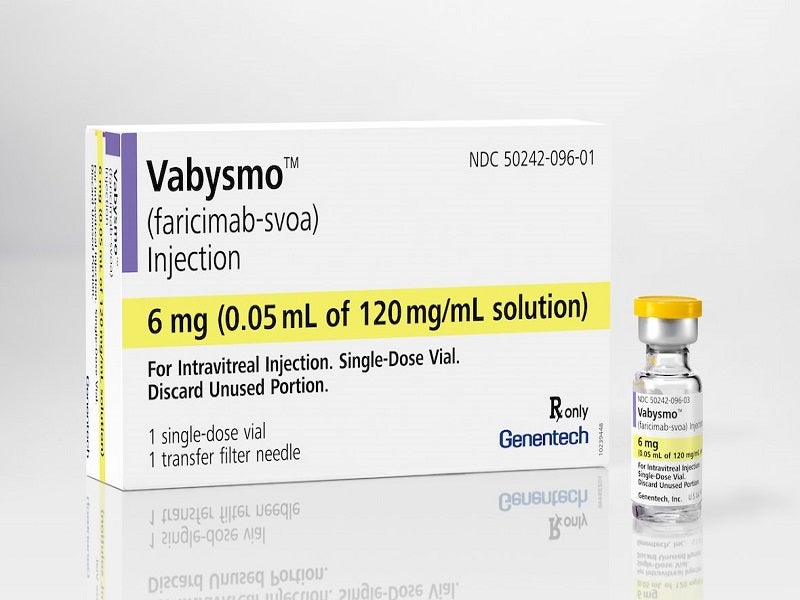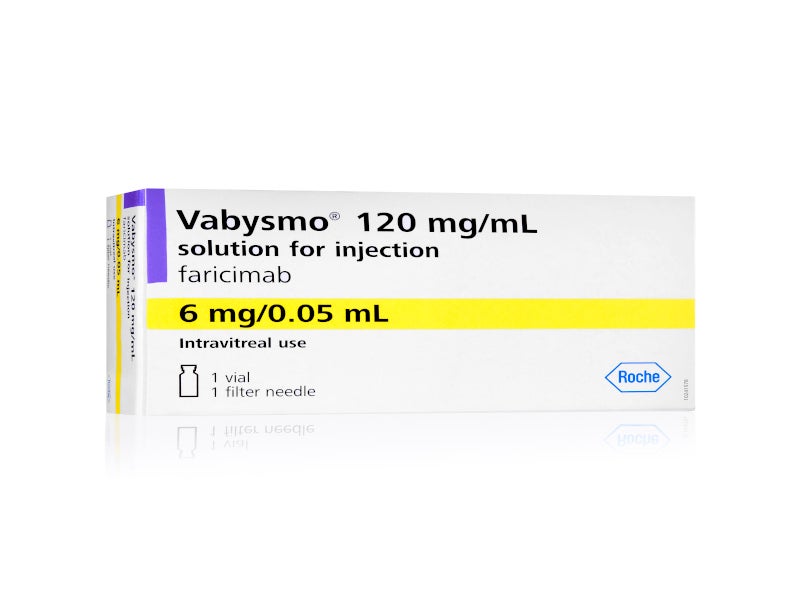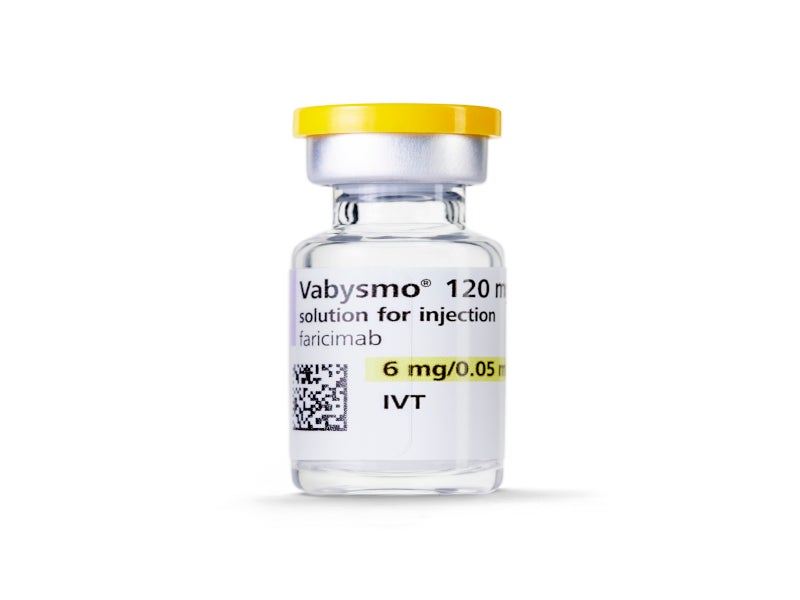Vabysmo™ (faricimab-svoa) is a bispecific antibody indicated for the treatment of adult patients with neovascular (wet) age-related macular degeneration (nAMD), diabetic macular oedema (DME), and retinal vein occlusion (RVO).
It is the first medicine designed to target and inhibit two distinct pathways that drive vision-threatening retinal diseases.
Developed by Roche Group subsidiary Genentech, Vabysmo is supplied as a sterile, clear to opalescent, colourless to brownish-yellow solution in a single-dose vial containing 120mg/ml of faricimab-svoa for intravitreal administration.
Regulatory approvals for Vabysmo
Genentech submitted a biologics license application (BLA) for Vabysmo for the treatment of patients with nAMD and DME to the US Food and Drug Administration (FDA), in May 2021. The application was accepted for priority review in July 2021.
The FDA approved the drug for the treatment of nAMD and DME in January 2022. The European Medicines Agency (EMA) also validated the marketing authorisation application submitted for Vabysmo for the treatment of nAMD and DME.
Chugai Pharmaceutical, a member of the Roche Group, received approval from Japan’s Ministry of Health, Labour and Welfare in March 2022 for Vabysmo for intravitreal injection for the treatment of nAMD and DME. The approval was based on four global phase III clinical trials named YOSEMITE and RHINE for DME, and TENAYA and LUCERNE trials for nAMD.
Health Canada approved Vabysmo for the treatment of nAMD and DME in June 2022. Vabysmo received European Union (EU) marketing authorisation in September 2022.
In May 2023, the FDA accepted the supplementary biologics licence application of Vabysmo (faricimab-svoa) for the treatment of macular oedema following RVO. The drug received FDA approval for the treatment of RVO in October 2023, based on positive results from the global Phase III BALATON and COMINO clinical studies.
Vabysmo is now licensed for the treatment of nAMD and DME in 80 countries, with approximately two million doses delivered globally.
nAMD, DME and RVO: causes and symptoms
Neovascular AMD and DME are two of the most common causes of vision loss among adults in the US, requiring treatment with eye injections once a month.
Age-related macular degeneration (AMD) damages the macular region of the retina at the back of the eye, which is crucial for precise, central vision required for activities such as reading. In the US, around 11 million people are affected with some form of AMD, including 1.1 million who suffer from nAMD.
nAMD is an advanced form of AMD that can cause quick deterioration of sight if left untreated due to an abnormal growth of blood vessels into the macula, also known as choroidal neovascularisation.
Symptoms of nAMD include blurred vision, difficulties in seeing from a distance or completing detailed work, blind spots developing in the line of sight, difficulty in differentiating colours and edges and straight lines appearing wavy.
Diabetic macular oedema (DME) is a retinal disorder associated with vision loss and poor quality of life if left untreated. The disease affects about 750,000 individuals in the US.
Macular oedema occurs when damaged blood vessels in the retina leak fluid or blood into the macula. The rising prevalence of diabetes is expected to increase the incidence of DME in patients.
Symptoms of DME include double vision, loss of contrast, floaters, blurred vision and patches of visual loss, which may appear as tiny black spots or lines floating across the front of the eye.
Retinal vein occlusion is the second most prevalent cause of vision impairment stemming from retinal vascular issues. It impacts more than a million individuals in the US, primarily those aged 60 or above, and can result in profound and abrupt vision deterioration. Elevated levels of angiopoietin-2 (Ang-2) characterise RVO, with the prevailing belief suggesting that heightened Ang-2 expression propels the advancement of the condition. RVO typically manifests as sudden and painless vision loss in the afflicted eye due to occlusion of the vein, impeding regular blood circulation within the affected retina. It consequently leads to ischemia, haemorrhaging, fluid leakage and macular oedema characterised by retinal swelling.
Collectively, the three retinal conditions impact around three million individuals in the US and are prominent contributors to vision impairment.
Vabysmo’s mechanism of action
Vabysmo is a humanised bispecific immunoglobulin G1 (IgG1) antibody that targets and inhibits two distinct pathways by binding to vascular endothelial growth factor-A (VEGF-A) and Ang-2.
Vabysmo suppresses endothelial cell proliferation, neovascularisation and vascular permeability by inhibiting VEGF-A, a protein whose overproduction causes the abnormal growth of blood vessels. The drug is expected to promote vascular stability and desensitise blood vessels to the effects of VEGF-A by inhibiting Ang-2, a protein whose overproduction causes vascular instability, leading to leakage, inflammation and stimulation of new blood vessels’ growth.
Ang-2 levels are elevated in some patients with nAMD and DME. The role of Ang-2 inhibition in the treatment effect and clinical response for nAMD and DME is yet to be determined.
Clinical trials on Vabysmo
The FDA’s approval for Vabysmo for nAMD and DME was based on the positive outcomes of four global, randomised, multi-centre, double-masked, active comparator-controlled, Phase III, two-year clinical studies named TENAYA, LUCERNE, YOSEMITE and RHINE.
TENAYA and LUCERNE evaluated Vabysmo’s safety and efficacy in 1,329 newly diagnosed nAMD patients who had not received any prior treatment for the condition, while YOSEMITE and RHINE evaluated the safety and efficacy of the drug in 1,891 diabetic patients with DME.
The safety and efficacy of Vabysmo and aflibercept were compared in the identically designed TENAYA and LUCERNE trials, as well as the YOSEMITE and RHINE trials.
The primary endpoint of the TENAYA and LUCERNE trials was the average change in best-corrected visual acuity (BCVA) score from baseline at weeks 40, 44 and 48, which is the best distance vision a patient can achieve, including correction with glasses.
The BCVA score averaged over weeks 48, 52 and 56 was the primary endpoint of the YOSEMITE and RHINE trials.
The average vision improvements from baseline in the patients administered with Vabysmo in the TENAYA and LUCERNE trials were +5.8 and +6.6 letters respectively, compared with +5.1 and +6.6 letters respectively in the patients who received aflibercept at one year.
The most common adverse reactions reported in patients during the TENAYA and LUCERNE trials were conjunctival haemorrhage, vitreous floaters, retinal pigment epithelial tears, an increase in intraocular pressure and eye pain.
In YOSEMITE, the average vision improvements from baseline at one year were +11.6 and +10.7 eye chart letters in the Vabysmo treat-and-extend and two-month groups respectively and +10.9 letters in the aflibercept group.
In the RHINE trial, the average vision improvements from baseline at one year were +10.8 and +11.8 letters in the Vabysmo treat-and-extend and two-month groups, and +10.3 letters in the aflibercept group.
The most common adverse reactions reported in patients in the YOSEMITE and RHINE trials included conjunctival haemorrhage, vitreous floaters and an increase in intraocular pressure.
All four studies achieved their primary endpoints with consistent administration of Vabysmo at up to four-month intervals and demonstrated non-inferior visual acuity improvements when compared with aflibercept administered every two months in the first 12-month period.
Vabysmo was generally well-tolerated, with a favourable benefit-risk profile in patients in all the studies.
Additional clinical studies on Vabysmo
The positive outcomes from the global Phase III BALATON and COMINO clinical studies demonstrated that monthly administration of Vabysmo led to early and sustained enhancement in vision among individuals with branch and central RVO.
The results met the primary endpoint of non-inferior visual acuity gains at 24 weeks compared to aflibercept. Additionally, data indicated that Vabysmo promptly and effectively reduced retinal fluid accumulation.
Throughout BALATON and COMINO, Vabysmo demonstrated generally good tolerability, with a safety profile consistent with earlier trials. The most prevalent adverse reaction observed was conjunctival haemorrhage.










